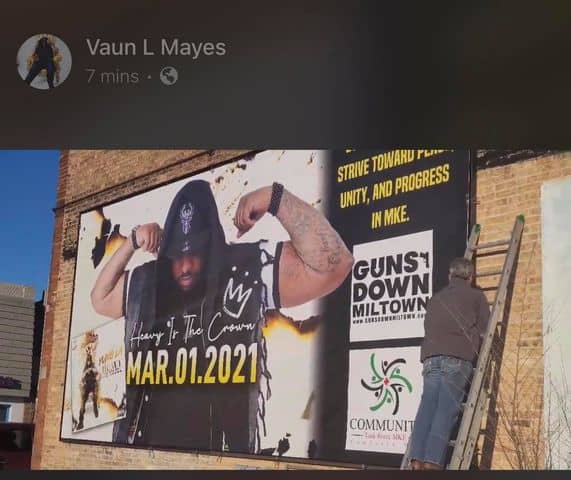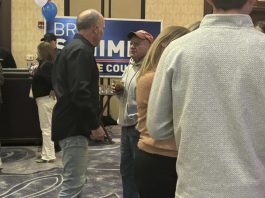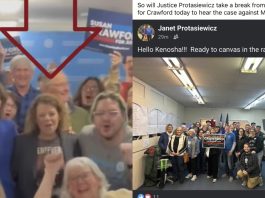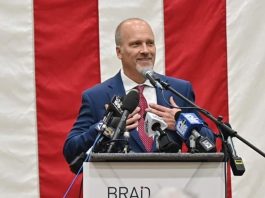The author is an African-American professional, born and raised in Milwaukee’s central city. She attended the University of Wisconsin-Milwaukee. Due to her job, she asked us not to print her name. We think what she has to say is incredibly important.
The mid-July sun was unmercifully hot, as I felt its heat against my bare shoulders. “It’s my turn!” Nina said excitedly. Yvette and I were turning the rope as fast as we could as Nina jumped in yelling “1-2-3 faster, faster!”
My neighbor’s apple red Chevy Caprice had just pulled up. He was about to get out of the car. Our child’s play was interrupted by screeching wheels, a barrage of sirens, as four police cars had drove up surrounding the neighbor’s car. One burly white officer yelled, “Throw your keys on the ground and get out slowly, with your hands up!” There were three other officers surrounding him as he exited the vehicle. They immediately rushed him with guns drawn. He stood facing the driver-side window of his car with his hands sprawled on the roof of his vehicle. His face gleamed with large droplets of perspiration on his forehead, as he nervously stammered, “Hey man, what’s this all about?”
“Shut up!” yelled one young White officer as he aimed a handgun toward my neighbor’s head, as another officer frisked him. My mom nervously exited our house to see what was going on, anxiously wiping her hands on her apron. She yelled, “Little girl, get in this house! Nina, Yvette, yawl go on home!”
Never taking my eyes off the dramatic and frightening scene unfolding, I slowly walked in the direction of the porch, never taking my eyes off my neighbor and the police officers.
My mom yanked me, “Get in this house, now!” Using her body to shield me from the perilous uncertainty that we were witnessing, holding me close to as her body blocked me from the visually violating view.
I had watched police officers chase bad guys on television and always felt a rush when the villain was caught. The neighbor was not like the villains I saw on television. As mom closed the door, I could hear my friend, his son crying “Daddy! Daddy! Don’t shoot my Daddy!”
The neighbor was not arrested that day. I never found out why he was targeted by the police.
While the killing of a handcuffed George Floyd replayed on national television and social media, I felt like that seven-year-old girl reliving the police encounter I witnessed with my neighbor. I felt hurt, sad, and angry. As the protests in Milwaukee unfolded, I watched the initial march from an open window at my job raising my fist in the air in support of the cause. I was standing up for my 7-year-old self from that stifling summer day years earlier.
Like many people who have protested and donated money, I wanted to feel a part of a movement and positive change. Like all of us, we grew up hearing about Dr. King, Malcolm X, John Lewis, and other activists who sacrificed their physical safety for other African-Americans to have opportunities that were not present before the Civil Rights Movement and afterward. While much progress has been made, there is still a lot more that must be accomplished to eradicate the inequities that exist socioeconomically, and in our educational and criminal justice systems.
At first, I applauded Frank Sensabaugh (known as Frank Nitty), Vaun Mayes, and Khalil Coleman for their efforts, compassion, and zeal to fight for the African-American community. I no longer feel that way. These activists, and the national Black Lives Matter (BLM) organization is not fighting for the equality of African-Americans. It is all about the money and fame.
I was taken aback by a live video from Frank Nitty while he was protesting through one of the suburbs in Milwaukee County. He and another female lead protester were having a heated disagreement about which direction to take during a night protest. In response to her resistance toward his suggestion, Nitty snapped, “All Black women want to do is argue and get drunk all of the time!” As African-American women, we are always fighting against negative and inaccurate stereotypes and here is a key local leader in a momentous national movement for equality, and the recipient of donations from all over the country and positive media coverage making disparaging comments about African-American women. During another protest, Nitty expressed irritation at LGBTQ hijacking the BLM Movement and that this movement was not about them. In other Facebook lives, Nitty used derogatory terms aimed at the LGBTQ population and criticized people for not having a thick skin when he used disparaging epithets to describe the LGBTQ population. As I had watched each live, Nitty was always pinning his cash app information soliciting donations, claiming they were for the movement so that protestors could have water, gas, and food.
A few weeks earlier, The Milwaukee Journal Sentinel published a glowing article about the Nitty and Coleman protest collaboration. This partnership was short-lived because of a verbal altercation that erupted on Facebook live between Nitty and Coleman about Nitty filming lives while protesting with The People Revolution (TPR) and posting his cash app information instead of the cash app information for TPR. Nitty repeatedly stated that he had sent $3,500 via cash app to Coleman. As the exchange became more heated, Nitty and Coleman began calling each other the N-word. That word is steeped in violent and traumatic imagery. This is what Nitty and Coleman were supposed to be fighting against. The movement that I had emotionally invested in to change the world and lives for African-Americans had now morphed into something disfigured and ugly in front of at least 10,000 people viewing the Facebook live across the country. I halted any further cash donations to Nitty or TPR.
As time passed, I also started to question what was being accomplished by the activists and the protests. I had always believed in the innocence of Vaun Mayes, and believed he was more transparent with his donations from the community. I was not initially deterred from supporting Mayes because of his Federal indictments.
I was disheartened by the incident on North 40th and West Lloyd Streets that transpired in June 2020. Initially, I thought there were some young girls caught up in a dangerous sex trafficking situation. When Mayes first arrived on the scene, there were not many people there. However, he gained more views of the incident as it unfolded, as he played amateur detective driving around the city to locate a mysterious van that had allegedly picked up the missing girls. Mayes then traveled back to the location where even more people had gathered. The situation grew more dangerous and volatile by the minute as misinformation was being gathered and disseminated on social media. Mayes cryptically said on his live: “This house is not going to be standing much longer.” Infuriated residents were already distrustful of the police who had already been at the residence numerous times to investigate the sex trafficking allegations. A van that was parked on the property was set ablaze. Then Nitty arrived with his iPhone in tow, filming a live feed on Facebook. At this point, a full riot occurred. As the police and the crowd engaged, gunshots rang out from someone in the crowd who was chasing and firing a gun at a black sedan fleeing the chaos. As the young man was firing at the car, Nitty yelled, “Boo, No!”
At that time, the house was fully engulfed in flames.
If the activists would have not meddled and allowed the police to do their job, the situation would not have escalated. After the instigators left, someone else did a live and several rounds from a semi-automatic were fired in the neighborhood in the pitch-black darkness of the night with not one activist in sight to mediate and stop the violence. Mayes and Nitty were clearly there to capitalize on the situation by doing lives and to garner media attention.
After seeing Mayes at the store with some youth buying toilet paper at a Target on 124th St. and W. Capitol Drive, Mayes filmed a Facebook live while accompanying the youth in the store. People that were viewing the live commented that they knew where the group was headed. Mayes exploded in villainous laughter, placing his finger up to his mouth saying, “Shhhh! For those of you that know, don’t say nothin.” After I learned of the shots fired incident at former Wauwatosa Police Officer Joseph Mensah’s home, I decided to read the Federal case against Mayes. I was horrified by what I read in the documents. There are at least 13 individuals who have accused Mayes of plotting to not only firebomb the 7th District Police Station, but two homes in West Allis. A youth was allegedly physically assaulted in retaliation for talking to law enforcement. A meme featured a menacing photo of Mayes with the words “Riot Snitches be like” scrawled across the image, court documents allege. In addition to the 13 individuals who have made statements against Mayes, there is compelling DNA evidence on the glass bottles used to make the Molotov Cocktails, federal prosecutors allege. Mayes’ hatred of law enforcement was evident when he protested outside of former Milwaukee Police Chief Alfonso Morales’s residence while his family was present. Mayes was in the street with fire blazing from a barbecue grill. His racist comments against a Latino Chief and his past inflammatory comments against the LGBTQ population as well have been spewed in comments and live videos on Facebook.
Local elected officials have accepted this horrible behavior and rewarded it with murals, “Frank Nitty Day,” resolutions and proclamations, for Mayes, Nitty and Coleman, who was recently charged with robbing a drug house and giving a gun to a juvenile to commit the robbery in Elsmere, Kentucky. On February 25, 2021, the charges were increased by the Commonwealth of Kentucky vs. Khalil Coleman.
I feel sad, angry and disillusioned because youth have looked up to Mayes, Nitty and Coleman. While our Black youth are intelligent, they come from homes steeped in trauma, poverty and violence, and as a result do not have self-worth. When someone like Coleman or Mayes comes around and shows an interest in them, giving validation, boxing lessons and fixing s’mores, these youth start to trust and view them as mentors. But none of these kind gestures were genuine. These vulnerable youth were allegedly expected to assist in firebomb plots and drug house robberies.
Toilet papering a house where law enforcement officers live and spearheading menacing protest parties at high-ranking law enforcement officials’ homes is not accomplishing equality for the African-American community or improving the trust and relationship between law enforcement and the African-American community. It makes me profoundly enraged when I think of all the planning and time that it took to harass Mensah but that same energy and focus is not placed on quelling the violence in the African-American community.
In August 2020, a young Black man who was about to start a job in Chicago, after graduating from college, was murdered inside of his grandparents’ house. His name was Roniel Sylvester Jr.
The grief-stricken father and his grandparents who witnessed this execution couldn’t get initial support from the alderman of the district in which the incident occurred, Khalif Rainey, nor any support from our community activists. However, our elected officials can pay tribute to the less than honorable behavior. The hypocrisy is appalling. To our esteemed community activists and our Black elected officials like State Representative David Bowen, State Senator Lena Taylor and others, a Black life appears to only matter when a police officer kills a Black person. If a Black life is lost outside of that circumstance, that Black life doesn’t appear to matter at all, except to the family and friends of the person who was murdered.
In late December 2020, in Columbus, Ohio, an unarmed black man was gunned down by a police officer. Nitty traveled to Columbus to protest with local BLM activists. While in Columbus, Nitty did a live with an Atlanta-based BLM activist Sir Maejor Page, legal name Tyree Conyers-Page. A criminal complaint was filed in the US Northern District of Ohio against Conyers-Page for money laundering and wire fraud. He is accused of using $200,000 of donations for personal use, including custom tailor-made suits and $150 neck ties. In the live with Conyers-Page and Nitty, they discussed activism and their dedication to the cause. Conyers-Page was wearing a tailor-made suit, self-promoting and grinning prior to a press conference to discuss the death of the Black man who was killed by police. The violent death of an unarmed Black man being shot and killed under any circumstance, police-involved or not, is a somber and horrific occasion. These two men were entertaining fans on Nitty’s live stream. Some might conclude it was not about the victim but being celebrities. They exited the vehicle like movie stars walking the red carpet at the Academy Award show as the local media awaited their comments. It was quite unnerving to see two black men using the death of another black man for their platform. The amount of donations Nitty has received is unknown. Since when has the plight of violence, trauma and racial inequities in the African-American community become a platform for activists to make money for iPhones, trips, clubs, clothes, and other personal uses?
The BLM Movement is a treasure trove and the number of donations to the BLM Movement have exponentially increased since the killing of George Floyd.
A June 2020 article posted on cbsnews.com stated that after George Floyd’s death, the BLM Movement raised $1.1 million dollars in individual donations or an average of $33 per person. The BLM Movement plans to offer $12 million in grants to other BLM organizations across the country to combat racism. According to an August 2020 article published by the New York Post, The BLM Movement has received over $1 billion in pledges from Corporate donors such as Facebook, Walmart, and Bank of America. There are dozens of BLM organizations across the country, and some are for-profit, while others have nonprofit statuses. The BLM organizations in New York, Vermont, Florida and South Carolina have had their nonprofit statuses revoked by the Internal Revenue Service for failing to file annual reports. With BLM having numerous organizations, and with various nonprofit and for-profit linked organizations scattered across the county, financial transparency is absent.
In another online story published on February 24, 2021 on CBS News.com BLM raised $90 million dollars in individual and partner donations in 2020; Of the $90 million raised, $21.7 million was distributed to 30 BLM chapters and $8.4 million was used for operating expenses.
Local activists Nitty, Mayes, and Coleman, do not make their earnings from donations public. Yet, individuals donate while Nitty says it is for the movement. Mayes attempts to be more transparent, but again, people are only privy to the amount that he is requesting. He does not make his total contributions, expenditures, or his salary public. Since Nitty has returned from his walk to Washington DC, he has filmed Facebook lives of himself eating grouper fish at Elsa’s, flashed his new iPhones, and someone filmed him outside of a Milwaukee strip club in a sparkling brand new White and Silver GMC Sierra truck.
The Civil Rights Movement did not have big corporate donors. Dr. Martin Luther King Jr. had the most profound effect during the Civil Rights era. Social media, iPhones, cash app and PayPal did not exist. Dr. King earned $8,000 per year as a minister to support himself and his family. He also won the Nobel Peace Prize in 1964 and he donated the $54,600 in proceeds from the prize to the Civil Rights Movement. There was also a group of dedicated African-American women who were excellent cooks and used their culinary skills to bake and sell food in return for donations to the movement. Little is known about Georgia Gilmore, an activist, cook and midwife who organized the African American female cooks who sold the baked goods during the 381-day bus boycott in Montgomery, Ala. Their efforts helped to pay for insurance, gas, vehicle repairs and wagons during the boycott.
There is no selflessness in today’s local activists — only selfishness and ego, while African-Americans are either in the graveyard or serving life sentences in the correctional system. None of the proceeds any of the activists or to the national BLM Movement are being used to make a difference in reversing the racial disparities that exist for African Americans in Milwaukee or across the country.
Matt V. Levine, Professor Emeritus and Founding Director, University of Wisconsin-Milwaukee’s Center for Economic Development, published a study in July 2020 titled, “The State of Black Milwaukee in National Perspective: Racial Equality in the Nation’s 50 Largest Metropolitan Areas In 65 Charts and Tables.”
Numerous disparities that are highlighted in this study exist for African Americans in the following areas:
- Poverty: African Americans in Milwaukee have the lowest median income. The poverty rate for Africa Americans is at 33.4 percent and is highest among the nation’s largest metropolitan areas
- Employment and Compensation: The African American male worker makes only 59.5% of a white worker’s earnings and only 14.6% of African American females in Milwaukee make $40,000 per years compared to 46.3% of white males
- Homeownership rate: Milwaukee ranks the second lowest in this area at a dismal 27.2% of African American homeowners.
- Incarceration rate: Milwaukee ranks third in the highest incarceration rate of African Americans in state prisons among the 50 largest metro areas in the US. The African American prison population in Milwaukee is 10 times the rate of White individuals.
The study also cites the inability of African-American youth to climb the socioeconomic ladder in Milwaukee. This gap is wider in Milwaukee than in Boston. I see a correlation with this grim statistic and the high homicide rate of African American youth in Milwaukee.
According to a January 2021 article in The Milwaukee Journal Sentinel, young African American males accounted for 80% of the 189 homicides in Milwaukee.
Mayes, Nitty or Coleman do not have viable solutions for these alarming disparities. The only solution is to defund the police. The outcry to defund the police of millions of dollars per year is simple. In an email addressed to the City of Milwaukee’s Finance and Personnel Committee during the 2021 Budget deliberations, Mayes wrote in an email, representing his organization Community Task Force Milwaukee or ComForce MKE, that any money that is defunded from the Milwaukee Police Department could benefit organizations such as Comforce MKE and other grassroots organizations in violence interruption and de-escalation. The horrific events that unfolded on 40th and West Lloyd Street in June 2020, and the violence that took place at Mensah’s residence in August did not look like violence de-escalation. Is the defunding rhetoric and trying to intimidate elected leaders into not accepting the federal grant to hire more police officers a ruse to divert taxpayers’ money to support unemployed men pretending to be community activists and their schemes disguised as programs to help the African-American community?
I have concluded that I am being exploited by people who look just like me and are supposedly fighting against an inequitable system that exploits African-Americans. I’m being exploited for my vote, my support and my money. How is that possible? Perhaps, because I wanted to be part of positive and historic change. I wanted to erase the memory of what I saw when I was 7-years-old when the police surrounded my friend’s father while he was unarmed. Many people of color have had negative interactions with law enforcement. In spite of the event I witnessed as a child, I know that exceptional police officers exist, who care about all people and view their positions as serving the community.
This past summer, during the height of the protests in the city, a young African-American woman was shot on West Atkinson Street on the North side of Milwaukee. Her lifeless body laid on the hot pavement, as bystanders had their phones out recording live videos for Facebook. One of the lives was uploaded to Facebook but was eventually taken down. A White police officer was performing CPR, pumping her chest as the crowd cursed at him saying he wasn’t doing anything to help her. The ambulance had not arrived, her breathing and heartbeat was faint. The officer continued trying to save her life. She did not survive. While that officer was there, the beloved community activists were in Wauwatosa intimidating store personnel at Mayfair Mall or doing lives while posting a cash app for donations going to no other worthy cause than ego and material goods.
As the protests in the city have slightly eased, local community activists like Vaun have found new ways to stay relevant and raise cash. He has a new alliance with Guns Down Miltown. On March 2, 2021, a billboard featuring Mayes, promoting his song “Heavy is the Crown”, was erected on a building on 37th and North Avenue. He was the focal point of the photo, with the Guns Down Miltown logo in the upper right corner. The violence in our community has ripped out the hearts of every mother of a child lost to violence. We need to hear their voice and see their pain to make a meaningful impact on decreasing gun violence in the city. This billboard was a lost opportunity to hear their voices and see their anguish.

The billboard is featuring a man accused of abusing his power with youth to taint then instead of making a meaningful and positive impact on their lives.
Instead, he mirrors violence, as a convicted felon accused of conspiring to blow up a police station, using youth to throw rocks to divert law enforcement’s attention. Our youth and community deserve much better.
As for me, I am just trying to heal that 7-year-old child from decades ago.







![WATCH: Elon Musk Town Hall Rally in Green Bay [FULL Video]](https://www.wisconsinrightnow.com/wp-content/uploads/2022/04/Elon_Musk_3018710552-265x198.jpg)



![The Great American Company [Up Against the Wall]](https://www.wisconsinrightnow.com/wp-content/uploads/2025/03/MixCollage-29-Mar-2025-09-08-PM-4504-265x198.jpg)
![The Wisconsin DOJ’s ‘Unlawful’ Lawman [WRN Voices] josh kaul](https://www.wisconsinrightnow.com/wp-content/uploads/2025/03/MixCollage-29-Mar-2025-08-48-PM-2468-265x198.jpg)